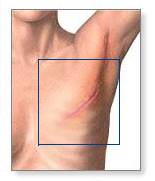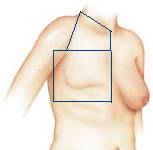see study and discussion below. Many
women are now getting adriamycin/cytoxan chemotherapy after mastectomy (rahterh than the
older and less effective CMF. The study below noted that even after adraimaycin, the risk
of local relaspe is still high and postOperative chest wall radiation is necessary.
Locoregional Recurrence Patterns After Mastectomy and
Doxorubicin-Based Chemotherapy: Implications for Postoperative Irradiation
By Angela Katz , Eric A. Strom, Thomas A.
Buchholz, Howard D. Thames, Cynthia D. Smith, Anuja
Jhingran, Gabriel Hortobagyi, Aman U. Buzdar, Richard
Theriault, S. Eva Singletary, Marsha D. McNeese
Journal of Clinical Oncology, Vol 18, Issue 15 (August), 2000:
2817-2827
From the Departments of Radiation Oncology, Biomathematics, Medical
Oncology, and Surgical Oncology, University of Texas M.D. Anderson Cancer Center, Houston,
TX.
PURPOSE: The objective of this study was to determine locoregional recurrence
(LRR) patterns after mastectomy and doxorubicin-based chemotherapy to define
subgroups of patients who might benefit from adjuvant irradiation. A
total of 1,031 patients were treated with mastectomy and doxorubicin-based
chemotherapy without irradiation on five prospective trials. Median follow-up
time was 116 months. Rates of isolated and total LRR (± distant metastasis)
were calculated by Kaplan-Meier analysis. The
10-year actuarial rates of isolated LRR were 4%, 10%, 21%, and 22% for patients
with zero, one to three, four to nine, or 10 involved nodes,
respectively. Chest wall (68%) and supraclavicular nodes (41%) were the most
common sites of LRR. T stage, tumor size, and 2-mm extranodal extension were
also predictive of LRR. Separate analysis was performed for patients with
T1 or T2 primary disease and one to three involved nodes (n = 404). Those with
fewer than 10 nodes examined were at increased risk of LRR compared with those
with 10 nodes examined (24% v 11%;). Patients with tumor size
greater than 4.0 cm or extranodal extension 2 mm experienced rates of
isolated LRR in excess of 20%. Each of these factors continued to significantly
predict for LRR in multivariate analysis by Cox logistic regression. CONCLUSION:
Patients with tumors 4 cm or at least four involved nodes
experience LRR rates in excess of 20% and should be offered adjuvant
irradiation. Additionally, patients with one to three involved nodes and large
tumors, extranodal extension 2 mm, or inadequate axillary dissections
experience high rates of LRR and may benefit from postmastectomy irradiation.
RANDOMIZED TRIALS that date back to the early 1970s have established that
adjuvant radiation therapy after mastectomy reduces the incidence of
locoregional recurrence (LRR) of breast cancer by approximately two thirds.
After the publication in 1987 of a meta-analysis by Cuzick et althat reported
increased mortality in women who had received postmastectomy radiotherapy as a
component of their treatment, its use was intensely challenged. An update published
in 1994 reported no significant difference in overall mortality. A similar
reduction in breast cancer mortality, as well as a two thirds reduction in LRR,
was reported in a third meta-analysis, which was published by the Early Breast
Cancer Trialists’ Collaborative Group.These authors also reported an
increase in non–breast cancer deaths, which was most evident for women
older than 60 years and which resulted in no difference in OS. More recently,
two trials published in the New England Journal of Medicine have
demonstrated superior locoregional control, DFS, and OS with the addition of
postoperative radiotherapy to mastectomy and chemotherapy. The Danish 82b trial
evaluated the use of postoperative radiotherapy in 1,708 high-risk
premenopausal women treated with mastectomy and CMF.At 10 years, there was
a decrease in LRR from 32% to 9% in the patients who received radiation to the
chest wall and regional lymphatics. This translated into improvements in both DFS (48% v
34%) and OS (54% v 45%;). Most surprising was the observation that
these significant improvements in DFS and OS were evident for all subgroups of
patients, including patients with one to three involved nodes. A second trial
from British Columbia also reported improvements in locoregional control
(87% v 67%) and DFS (50% v 33%) in node-positive premenopausal
women treated with adjuvant radiation after mastectomy and CMF.Similar benefits
in postmenopausal women treated with mastectomy and tamoxifen were recently
reported by the Danish Breast Cancer Cooperative Group.
Together, these trials have demonstrated that the improvement in
locoregional control observed with adjuvant irradiation translates into an
improvement in OS. It is, therefore, imperative to identify those patients at
significant risk of LRR who are most likely to realize the benefit of adjuvant
irradiation. Our analysis of recurrence patterns in 1,031 patients found that
doxorubicin-based adjuvant systemic therapy does not obviate the need for
postmastectomy irradiation for subsets of breast cancer patients at substantial
risk of LRR. Patients with tumors larger than 4 cm or involvement of four or
more axillary lymph nodes experienced rates of
isolated LRR in excess of 20%. The results of the Danish trial demonstrated
that the reduction in LRR observed with the addition of radiotherapy in
patients with comparable LRR rates translated into an absolute benefit in
DFS of 10% and an absolute benefit in OS of approximately 6%. This survival
benefit is similar in magnitude to that achievable with adjuvant systemic
therapy. Together, these data suggest that all patients with tumors
larger than 4 cm or with four or more involved axillary lymph nodes should be
offered postoperative radiotherapy.
The risk of LRR and, thus, the value of postmastectomy radiotherapy in
patients with one to three involved nodes remain controversial. Although the
Danish group observed an improvement in OS for this subset of patients, the
reported LRR rate of 30% was much greater
than that reported in other studies, in which it ranged from 5% to 20%.As a
group, patients with stage II breast cancer and one to three involved nodes
experienced a low risk of LRR (10% isolated LRR and 14% total LRR). However,
there were subsets of these patients who were observed to have a much higher
risk of LRR. These include patients with tumors larger than 4.0 cm (26%
isolated LRR risk) or with lymph node disease displaying extranodal extension
> 2 mm (33% isolated LRR risk). Because patients without these risk
factors who have undergone an adequate axillary dissection have a low risk of
LRR, any survival benefit from adjuvant radiotherapy is likely to be small.
Although the proportional reduction in breast cancer deaths in these low-risk
patients is likely to be similar to that of those at greater risk of LRR, the
absolute benefit would be expected to be modest. Assuming
the same proportional risk reductions observed in the British Columbia and
Danish Cooperative Group trials, a reduction in LRR rates from 10% to
3% with comprehensive postmastectomy irradiation would be predicted to result
in a 3% survival advantage for these low-risk patients. The specific threshold
of LRR risk that warrants the addition of adjuvant irradiation is debatable and
requires the clinical judgment of the physician in consultation with individual
patients. In fact, the threshold for the recommendation of adjuvant systemic
therapy has gradually been lowered over the years, and for many patients,
absolute survival benefits of less than 10% are considered acceptable
indications for adjuvant therapy.
Consistent with most previous reports,our study found that the chest wall
and supraclavicular fossa are the most common sites of LRR. The low overall
rates of axillary recurrence do not support the routine supplementation of
axillary dose beyond that delivered by the supraclavicular/axillary apex field
and the chest wall tangents. Although the rate of documented IMC failures
in our cohort was quite low, CT scans and ultrasound were not routinely
performed as screening procedures in these patients, many of whom were treated
before the routine use of CT scans. It is, therefore, possible that many IMC
recurrences went undetected. Indeed, despite the observation that these clinical
recurrences are rare, autopsy and surgical reports have documented microscopic
involvement of the IMC nodes in up to 25% of node-positive patients with outer
quadrant tumors and 50% of those with central/inner quadrant tumors.Whether
subclinical involvement of these nodes is a source of seeding for distant
metastasis is also unknown. The indications for treatment to the regional
lymphatics, particularly the use of a posterior axillary supplemental field and
targeting of the IMC nodes, remain questions worthy of further study.
The results of this analysis demonstrate that doxorubicin-based chemotherapy
does not obviate the need for postmastectomy irradiation. Patients with zero,
one to three, four to nine, and 10 or more involved nodes experience isolated
LRR rates of 4%, 10%, 21%, and 22%, respectively. The corresponding rates of
total LRR are 7%, 14%, 25%, and 34%, respectively. Because of the longer duration
of follow-up and precise definition of isolated and total LRR in the current
series, these rates are consistent with previous reports from our institution.
Our results also support the recently published recommendations of the American
Society for Therapeutic Radiology and Oncology (ASTRO) consensus statement
regarding the indications for postmastectomy irradiation.We conclude that patients with
stage II disease and four or more involved nodes or stage III disease are at
the greatest risk of isolated LRR and are most likely to derive a benefit from
the addition of postmastectomy irradiation. Taken as a whole, patients with
stage II breast cancer and one to three involved lymph nodes are at low risk of
LRR, and the corresponding absolute benefit in survival derived from
postmastectomy irradiation is likely to be small. However, there may be a
subset of these patients who are also at a significant risk of LRR and for whom
adjuvant irradiation should be considered. These include patients with
large tumors, those with extranodal extension > 2 mm, and those who have not
undergone an adequate axillary dissection.
The question of whether radiation benefits subgroups of stage II patients
with one to three involved nodes takes on increased importance with the growing
evidence that modern radiotherapy has the potential to improve survival in
properly selected patients. Because our experience does not reproduce the
findings of the recent prospective trials, it is difficult to justify the
routine use of postmastectomy irradiation in patients with one to three involved
nodes unless other risk factors are present. The results of this study support
the need for a prospective, randomized trial to specifically assess the role of
postmastectomy irradiation in this patient group.
|

